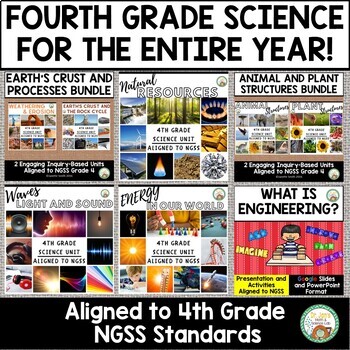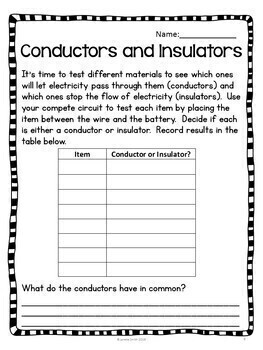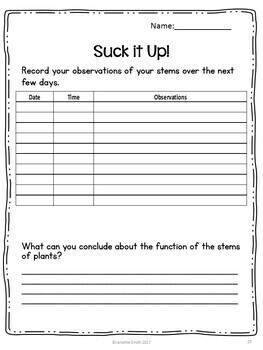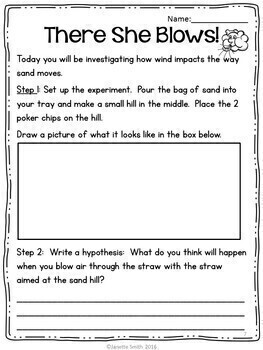4th Grade Science -NGSS- Entire Year Bundle
- Zip
What educators are saying
Products in this Bundle (8)
showing 1-5 of 8 products
Bonus
Also included in
- I decided to put this MEGA BUNDLE together because I have noticed that several buyers purchase multiple SCIENCE ENTIRE YEAR Super Bundles for different grade levels. I’m guessing these buyers are science teachers at the elementary level, homeschool parents with multiple levels of kids, or principalPrice $342.16Original Price $427.70Save $85.54
- This product has everything you need to teach 4th grade science. All activities and presentations are aligned to the Next Generation Science Standards (NGSS) for 4th Grade. Included in this product are 6 hands on units that teach all of the NGSS standards for 4th grade, as well as PowerPoints to sPrice $75.68Original Price $94.60Save $18.92
- This Bundle includes 6 Units to teach every NGSS standard for 4th Grade Science. This bundle includes both PDF Printable Files and the Google Classroom™ Digital Format. Presentations are also in Google Slides format and PowerPoint.This product gives teachers options to provide some activities in pPrice $124.00Original Price $155.00Save $31.00
Description
This bundle includes 6 hand-on science units aligned to the Next Generation Science Standards (NGSS) for 5th grade. Each unit is packed full of inquiry-based activities, integrated language arts, word wall cards, games, task cards, projects, and assessments. Teacher pages, assessments, and answer keys are also included. Here's a brief description of each unit. If the preview is difficult to see, you can visit the page for each item by clicking the links since each unit is also sold separately. You will save money by purchasing all of these units.
***Also Available: PowerPoint bundle to support these units. Check it out here.***
If you are interested in this product plus the 6 PowerPoint Bundle, check out my 4th Grade Super Bundle.
******Bonus Implementation Guide Included with lists of materials, a brief overview of the NGSS and a matrix that aligns all activities with the 4th grade standards.*********
Here's what's included:
Unit 1: Earth Science Bundle
Earth's Crust and the Rock Cycle:
Activity 1: Classifying Rocks Students classify rocks into 3 groups using observations.
Activity 2: Rock On!: Students simulate the rock cycle using gum and pop rocks.
Activity 3: Pangaea Activity: Students create a puzzle using the continents to demonstrate Pangea.
Activity 4: Shake it Up: Students create structures out of toothpicks and mini marshmallows and then test their strength in an earthquake simulation.
Activity 5: Stress Me Out!: Students use a miniature candy bar to simulate the 3 different types of stresses on the Earth’s crust.
Activity 6: Word Wall cards and Activity Ideas
An optional post test and grading rubric are also included.
•Activity 1: There She Blows: Students investigate wind erosion using a straw and sand.
•Activity 2: Sticks and Stones: Students investigate water erosion with a mudslide simulation.
•Activity 3: Sugar Cube Shake: Students investigate mechanical weathering with a sugar cube experiment.
•Activity 4: Water and Weathering: Students investigate the impact of chemical weathering using temperature as a variable.
•Activity 5: Chemical Weathering: Students investigate the impacts of chemicals on weathering using chalk and vinegar.
•Activity 6: Informational Reading on Acid Rain
•Activity 7: Weathering or Erosion? Students read scenarios and identify which parts are the weathering and which are erosion.
•Activity 8: Weathering and Erosion Bingo: Students wrap up the unit by playing Weathering and Erosion Bingo. This serves as a great review of vocabulary. A supplemental thermometer reading practice is also included.
•Activity 9: Word Wall Cards and Games
•Post tests (2 options)
Unit 2: Energy
•Activity 1 Energy Sort: Students sort a variety of images into different types of energy.
•Activity 2 Heatin’ Up: Students experiment with the concept of heat transfer by comparing how different materials heat up from the sun’s energy.
•Activity 3 Marble Mania: Students experiment with marbles to see how varying speeds of an object can change the amount of energy that is transferred from one object to another.
•Activity 4: Energy Change in a Car Crash: Students read about how energy is dispersed in a car crash and then answer a few questions about what they read.
•Activity 5: Melt My Ice: Students investigate the transfer of heat energy as they try to melt an ice cube the fastest.
•Activity 6 Light It Up: Students investigate different ways to make a light bulb light.
•Activity 7: Electricity in My Everyday Life: Students brainstorm all the ways they use electricity in an average day.
•Activity 8: Electromagnets: Students make a simple electromagnet to see how energy can be converted from one form to another.
•Activity 9: Potential and Kinetic Energy Informational reading passage with comprehension questions.
•Activity 10 Launch It: Students experiment with a catapult to further explore potential and kinetic energy.
•Activity 11: The Law of Conservation of Energy Activity
•Word Wall Cards and Games
•Post Test (2 options with answer key)
Unit 3: Plant and Animal Structures
Activity 1: Sprouting Seeds Students will sprout a seed in a Ziploc bag with cotton balls. They will observe and record the growth.
Activity 2: It All Starts With A Seed Students will examine different seeds and compare information from seed packets.
Activity 3: Plant Life Cycle Students will put pictures of different stages of a plant’s life cycle in order.
Activity 4: Honey Bee Informational Reading Students will read about how honey bees pollinate flowers.
Activity 5: Inside A Flower: Students will dissect a flower and observe the reproductive parts.
Activity 6: Suck it Up!: Students will observe how stems suck water up into the leaves and flowers of plants.
Activity 7: Putting Down Roots: Students will observe different types of roots and make conclusions as to their function.
Activity 8: Leave it to the Leaves: Students will read about the process of photosynthesis and answer questions.
Post Test and Grading Rubric are also included.
Activity 1: My Beak is Better Than Yours: Students focus on the beak structure of birds and how this specific structure helps them get food.
Activity 2: Salmon Swim Home: This engaging activity gives students the opportunity to become salmon and use their sense of smell to navigate home.
Activity 3: Poster Reports: These reports focus on structures of animals and how they help with nutrition, self-defense, reproduction, and communication.
A Grading Rubric is included for the poster report.
Unit 4: Light and Sound:
Activity 1: Word Wall Cards and Activities: Word cards, definitions and suggested activities to reinforce key vocabulary from the unit.
Activity 2: Good Vibrations: Students make a simple straw oboe to investigate vibrations and sound
Activity 3: Waves: Students read about waves, study a diagram, and answer questions.
Activity 4: Making Waves: Student use a jump rope to create waves with specific amplitudes and frequencies.
Activity 5: What’s That Sound: Students make a simple kazoo and experiment with sound.
Activity 6: Pan Pipes: Students make Pan Pipes out of straws.
Activity 7: How Do Our Ears Hear? This informational reading passage, diagram, and questions is designed to explain how our ears process sound.
Activity 8: Mirror Mirror on the Wall: Students investigate reflection of light using a mirror.
Activity 9: How Does Light Travel? Students discover which materials are opaque, translucent, and transparent.
Activity 10: Light Moves: Students investigate how light appears to bend as it enters different mediums such as water.
Activity 11: Visible Spectrum: Students see “rainbows” on a CD and learn about the visible spectrum.
Activity 12: How Do Eyes See? This informational reading passage, diagram, and questions is designed to explain how our eyes process light.
Post Test and Grading Rubric are also included.
Unit 5: Natural Resources
Activity 1: What is a Natural Resource?: Students watch an introductory video and then find natural resources within their own classroom.
•Activity 2: Renewable and Non-Renewable Resources Students work cooperatively to sort resource cards into renewable and non-renewable resources.
•Activity 3: Dig it Up Students do a simulation to see how non-renewable resources become scarce as time goes on.
•Activity 4: Making a Solar Oven: Students make a solar oven using foil and a pizza box. They then cook marshmallows and make s'mores.
•Activity 5: Earth’s Water: Students discover that the amount of usable water on earth is very small.
•Activity 6: What are Fossil Fuels? Informational reading passage with comprehension questions.
•Activity 7: Water Wheel: Students make a water wheel and investigate how water’s energy can be transferred to other types of energy.
•Activity 8: Conservation of Earth’s Resources Poster: Now that students have learned about our Earth’s natural resources, they design a poster to spread the importance of conservation. A grading rubric is provided for the poster.
•Word Wall Cards and Games
•Post Test
Unit 6: Introduction to Engineering
In addition to the activities, a powerpoint is also included with this unit.
Activity 1: Float Your Boat: Students go through the engineering design process to create a boat. Once the boat successfully floats, they place marbles in it to see how many it can hold.
Activity 2: Build A Bridge: Students go through the engineering design process to build a bridge. After the bridge is built, they test it to see how many pennies it can hold.
Activity 3: Keep it Cold: This engaging activity challenges students to create a container to keep an ice cube frozen for as long as possible. This could easily be turned into a classroom contest.
Activity 4: Engineering Design Process Flow Chart: Students can use this sheet to review the steps they went through in the completed engineering design assignments. This could potentially be used as an assessment.
This bundle was created for the 4th grade NGSS standards, but all of these units are suitable for grades 3-5
This product is now also available in a digital format for use with Google Classroom. Check that out here.
If you want BOTH printable and digital formats click here.
If you like this product, consider following my store! I have a lot of science and math products for upper elementary grades. New products are 50% off for the first 48 hours.
Also, please leave feedback! You can earn TpT credits for future purchases!
Teach Kindergarten? Check out the NGSS Entire Year Bundle:
Teach 1st Grade? Check out the NGSS Entire Year Bundle:
Teach 2nd Grade? Check out the NGSS Entire Year Bundle:
Teach 3rd Grade? Check out the NGSS Entire Year Bundle:
Teach 5rh Grade? Check out the NGSS Entire Year Bundle:
Are you a principal, elementary science teacher or homeschool parent interested in these Entire Year Bundles for multiple grade levels? You can now purchase the NGSS Mega Bundle for an even bigger discount. This MEGA BUNDLE includes entire year science bundles aligned to NGSS for grades 1-5. Check it out here:
******Click Here to Download a FREE Science Research Report resource******
*The Next Generation Science Standards (NGSS) is a registered trademark of WestEd. Neither WestEd nor the lead states and partners that developed the Next Generation Science Standards were involved in the production of this product, and do not endorse it.








